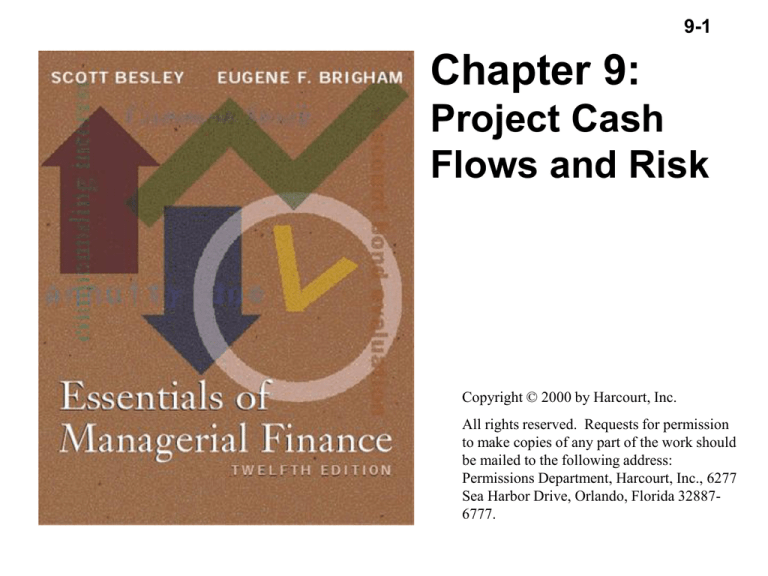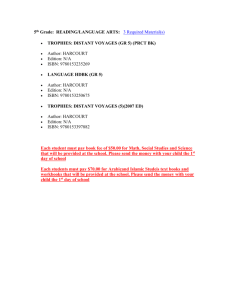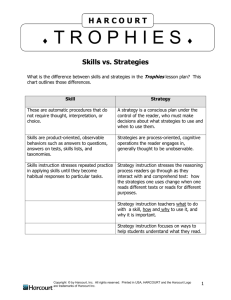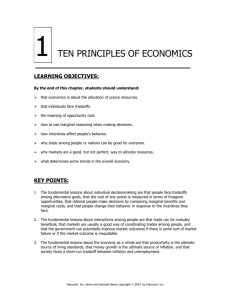
9-1
Chapter 9:
Project Cash
Flows and Risk
Copyright © 2000 by Harcourt, Inc.
All rights reserved. Requests for permission
to make copies of any part of the work should
be mailed to the following address:
Permissions Department, Harcourt, Inc., 6277
Sea Harbor Drive, Orlando, Florida 328876777.
Copyright (C) 2000 by Harcourt, Inc. All rights
reserved.
9-2
Cash Flow Estimation
Most important and most difficult step in
the analysis of a capital project
Financial staff’s role includes:
Coordinating the efforts of other
departments
Ensuring that everyone uses the same
set of economic assumptions
Making sure that no biases are
inherent in the forecasts
Copyright (C) 2000 by Harcourt, Inc. All rights
reserved.
9-3
Relevant Cash Flows
Cash Flow Versus Accounting Income
Incremental Cash Flows
Copyright (C) 2000 by Harcourt, Inc. All rights
reserved.
9-4
Cash Flow Versus
Accounting Income
2001 Situation
Accounting Profits
Cash Flows
Sales
$50,000
$50,000
Costs except depreciation
(25,000)
(25,000)
Depreciation
(15,000)
Net operating income or cash flow
$10,000
Taxes based on operating income (30%)
(3,000)
Net income or net cash flow
$7,000
-$25,000
(3,000)
$22,000
Net cash flow =
Net income plus depreciation = $7,000 + $15,000 = $22,000
Copyright (C) 2000 by Harcourt, Inc. All rights
reserved.
9-5
Cash Flow Versus
Accounting Income
2006 Situation
Accounting Profits
Cash Flows
Sales
$50,000
$50,000
Costs except depreciation
(25,000)
(25,000)
Depreciation
Net operating income or cash flow
Taxes based on operating income (30%)
Net income or net cash flow
(5,000)
$20,000
(6,000)
$14,000
-$25,000
(6,000)
$19,000
Net cash flow =
Net income plus depreciation = $14,000 + $5,000 = $19,000
Copyright (C) 2000 by Harcourt, Inc. All rights
reserved.
9-6
Incremental Cash Flows
An Incremental Cash Flow is the change in a
firm’s net cash flow attributable to an
investment project
Copyright (C) 2000 by Harcourt, Inc. All rights
reserved.
9-7
Problems in Determining
Incremental Cash Flows
Sunk Cost: A cash outlay that already has been
incurred and cannot be recovered
Opportunity Cost: The return on the best
alternative use of an asset
Externalities: The effect accepting a project will
have on the cash flows in other parts of the firm
Shipping and Installation Costs
Inflation
Copyright (C) 2000 by Harcourt, Inc. All rights
reserved.
9-8
Identifying Incremental
Cash Flows
Initial Investment Outlay: The incremental cash
flows associated with a project that will occur
only at the start of a project’s life CF0
Incremental Operating Cash Flow: The changes
in day-to-day cash flows that result from the
purchase of a capital project and continue until
the firm disposes of the asset
Terminal Cash Flow: The net cash flow that
occurs at the end of a project’s life
Copyright (C) 2000 by Harcourt, Inc. All rights
reserved.
9-9
Incremental Operating Cash
Flow
Incremental
operating = DNIt + DDeprt
cash flowt
= DEBTt X (1 - T) + DDeprt
= (DSt - DOCt - DDeprt) X (1 - T) + DDeprt
= (DSt - DOCt) X (1 - T) + T(DDeprt)
Copyright (C) 2000 by Harcourt, Inc. All rights
reserved.
9-10
Capital Budgeting Project
Evaluation
Expansion Project: A project that is intended to
increase sales
Replacement Analysis: An analysis involving the
decision of whether to replace an existing asset
that is still productive with a new asset
Copyright (C) 2000 by Harcourt, Inc. All rights
reserved.
9-11
Expansion Project
Analysis of the Cash Flows
Initial Investment Outlay
Shipping & installation
Increase in NWC
Initial Investment
2000
$(9,500)
(500)
(4,000)
$(14,000)
Incremental Operating Cash Flow
Sales revenue
Variable Costs
Fixed Costs
Depreciation on new equipment
Earnings before taxes (EBT)
Taxes (40%)
Net Income
Add back depreciation
Incremental operating cash flows
2001
2002
2003
2004
$30,000 $30,000 $30,000 $30,000
(18,000) (18,000) (18,000) (18,000)
(5,000) (5,000) (5,000) (5,000)
(2,000) (3,200) (1,900) (1,200)
$5,000 $3,800 $5,100 $5,800
(2,000) (1,520) (2,040) (2,320)
$3,000 $2,280 $3,060 $3,480
2,000
3,200
1,900 1,200
$5,000 $5,480 $4,960 $4,680
Copyright (C) 2000 by Harcourt, Inc. All rights
reserved.
9-12
Expansion Project
Analysis of the Cash Flows
Year
2001
2002
2003
2004
Incremental Operating Cash Flow Computation
$5,000 =
$5,480 =
$4,960 =
$4,680 =
($30,000 - $18,000 - $5,000)
($30,000 - $18,000 - $5,000)
($30,000 - $18,000 - $5,000)
($30,000 - $18,000 - $5,000)
(1 – 0.40)
(1 – 0.40)
(1 – 0.40)
(1 – 0.40)
+ $2,000(0.40)
+ $3,200(0.40)
+ $1,900(0.40)
+ $1,200(0.40)
Copyright (C) 2000 by Harcourt, Inc. All rights
reserved.
9-13
Expansion Project
Analysis of the Cash Flows
2000
2001
2002
Terminal Cash Flow
Return of net working capital
Net salvage value
Terminal Cash Flow
Annual Net Cash Flow
Total net cash flow/year
Net Present Value
2003
2004
$4,000
1,800
$5,880
$(14,000)
$5,000
$5,480
$4,960 $10,560
$3,790
Copyright (C) 2000 by Harcourt, Inc. All rights
reserved.
9-14
Expansion Project
Cash Flow Time Line
2000
2001
0
1
k = 15%
(14,000)
4,384
4,143
3,261
6,038
NPV = $3,790
Net cash
flows
IRR =
26.3%
5,000
2002
2
2003
3
2004
4
5,480
4,960
10,560
Payback period = 2.7 years
Copyright (C) 2000 by Harcourt, Inc. All rights
reserved.
9-15
Replacement Project
Analysis of the Cash Flows
2000
Initial Investment Outlay
Cost of new asset
Change in net working capital
Net cash flow/sale of old asset
Initial Investment
2001
2002
2003
2004
2005
$(12,000)
(1,000)
1,600
$(11,400)
Incremental Operating Cash Flow
D Operating costs
D Depreciation
D Earnings before taxes (EBT)
D Taxes (40%)
D Net Income
Add back D depreciation
Incremental operating cash flows
$3,500
(3,460)
40
(16)
24
3,460
$3,484
$3,500 $3,500 $3,500 $3,500
(4,900) (1,300)
(340)
500
(1,400) 2,200
3,160 4,000
560
(880) (1,264) (1,600)
(840) 1,320
1,896 2,400
4,900 1,300
340
(500)
$4,060 $2,620 $2,236 $1,900
Copyright (C) 2000 by Harcourt, Inc. All rights
reserved.
9-16
Replacement Project
Analysis of the Cash Flows
2000
Terminal Cash Flow
Return of net working capital
Net salvage value of new asset
Terminal Cash Flow
Annual Net Cash Flow
Total net cash flow each year
Net Present Value (15%)
2001
2002
2003
2004
2005
$1,000
1,200
$2,200
$(11,400)
$3,484 $4,060 $2,620 $2.236 $4,100
$(261)
Copyright (C) 2000 by Harcourt, Inc. All rights
reserved.
9-17
Replacement Project
Cash Flow Time Line
2000
0
2001
1
2002
2
2003
3
2004
4
2005
5
3,484
4,060
2,620
2,236
4,100
k = 15%
Net cash
flows (11,400)
3,030
3,070
1,723
1,278
2,038
NPV = $(261)
IRR = 14.0%
Payback period = 3.6 years
Copyright (C) 2000 by Harcourt, Inc. All rights
reserved.
9-18
Introduction to Project
Risk Analysis
Stand-Alone Risk: The risk an asset would have if it
were a firm’s only risk
Measured by the variability of the asset’s expected returns
Corporate (Within-Firm) Risk: Risk not considering
the effects of stockholder’s diversification
Measured by a project’s effect on the firm’s earnings
variability
Beta (Market) Risk: Part of a project’s risk that cannot
be eliminated by diversification
Measured by the project’s beta coefficient
Copyright (C) 2000 by Harcourt, Inc. All rights
reserved.
9-19
Techniques for Measuring
Stand-Alone Risk
Sensitivity Analysis: Key variables are
changed and the resulting changes in the
NPV and the IRR are observed
Scenario Analysis: “Bad” and “good” sets of
financial circumstances are compared with
the most likely situation.
Monte Carlo Simulation: Probable future
events are simulated on a computer
Copyright (C) 2000 by Harcourt, Inc. All rights
reserved.
9-20
Sensitivity Analysis Graph
NPV (000s) 80
Unit sales
60
40
20
SV
0
k
-20
-40
-30
-60
-20
-10
0
Base
10
20
30
% change
from base
Copyright (C) 2000 by Harcourt, Inc. All rights
reserved.
9-21
Scenario Analysis
Assume we know all variables except unit sales,
which could range from 75,000 to 125,000 (or 75
to 125). Here are the scenario NPVs:
Scenario
Probability
NPV (000)
Worst
0.25
-$27.8
Base
0.50
15.0
Best
0.25
57.8
E(NPV) =
(NPV) =
$15.0
$30.3
Copyright (C) 2000 by Harcourt, Inc. All rights
reserved.
9-22
Scenario Analysis
Standard Deviation:
NPV = $30.3
Coefficient of Variation:
σ
$30.3
NPV
CV
2 .0
NPV ENPV $15
Copyright (C) 2000 by Harcourt, Inc. All rights
reserved.
9-23
Advantages / Disadvantages of
Simulation Analysis?
Advantages
Reflects probability of each input.
Shows range of NPVs, expected
NPV, NPV, and CVNPV.
Disadvantages
Difficult to specify probability
distributions and correlation.
If inputs are bad, output will be bad:
GIGO = Garbage In, Garbage Out!
Copyright (C) 2000 by Harcourt, Inc. All rights
reserved.
9-24
Beta (or Market) Risk
Beta Risk and Required Rate of
Return for a Project
Security Market Line equation:
kS = kRF + (kM - kRF)bs
Erie Steel is all equity financed, so cost of equity is also
its averaged required rate of return, or cost of capital.
Erie’s b = 1.1; kRF = 8%; and kM = 12%
kS = 8% + (12% - 8%) = 12.4% = Erie’s cost of equity
Investors should be willing to give Erie money to invest
in average-risk projects.
Copyright (C) 2000 by Harcourt, Inc. All rights
reserved.
9-25
Project Required Rate of Return,
kproj
kproj = The risk adjusted required
rate of return for an individual
project
kproj = kRF + (kM - kRF)bproj
Copyright (C) 2000 by Harcourt, Inc. All rights
reserved.
9-26
Measuring Beta Risk
for a Project
Pure Play Method:
Identify companies whose only
business is the project in question
Determine the beta for each company
Average the betas to find an
approximation of proposed project’s
beta
Copyright (C) 2000 by Harcourt, Inc. All rights
reserved.
9-27
How Project Risk Is Considered in
Capital Budgeting Decisions
Most firms use:
Risk Adjusted Discount Rate
Discount rate that applies to
particularly risky stream of income
It is equal to the risk-free rate of
interest plus a risk premium
Copyright (C) 2000 by Harcourt, Inc. All rights
reserved.
9-28
Capital Rationing
A situation in which a constraint is
placed on the total size of the firm’s
capital investment.
Copyright (C) 2000 by Harcourt, Inc. All rights
reserved.
9-29
Multinational
Capital Budgeting
Repatriation of Earnings: The process of
sending cash flows from a foreign subsidiary back
to the parent company.
Exchange Risk Rate: The uncertainty associated
with the price at which the currency from one
country can be converted into the currency of
another country.
Political Risk: The risk of seizure of a foreign
subsidiary’s assets by the host country or
unanticipated restrictions on cash flows to the
parent company.
Copyright (C) 2000 by Harcourt, Inc. All rights
reserved.
9-30
End of Chapter 9
Project Cash Flows
and Risk
Copyright (C) 2000 by Harcourt, Inc. All rights
reserved.









